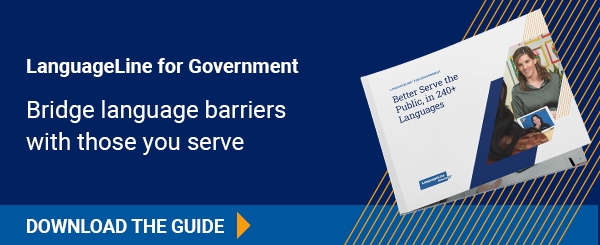
Nearly all government agencies and organizations that receive federal funds are required by law to provide limited English proficient (LEP) persons “meaningful access” to their services.
What Exactly Does “Meaningful Access” Really Mean? Where Did This Requirement Come From?
The standard for meaningful access evolved from Title VI of the Civil Rights Act of 1964 and its prohibition against discrimination on the basis of national origin. In 2000, Executive Order 13166 strengthened Title VI protections with the goal of improving access to government services for persons who were limited English proficient due to their nation of origin.
How Far Reaching? What Organizations Must Comply?
EO 13166 applies directly to federal agencies and recipients of federal funding. Considering how federal funds flow into government agencies at all levels, as well as non-profits and other organizations, EO 13166 affects thousands of organizations. These organizations offer programs and services in countless fields, including social services, healthcare, public safety, education, justice, transportation, housing, and more.
Identifying “Meaningful Access”
EO 13166 requires organizations to assess the services they offer, determine which of those services may be needed by LEP persons, and then develop a system to provide “meaningful access” without unduly burdening the agency. As a starting point, the U.S. Department of Justice’s “four-factor analysis” provides a self-assessment structure:
- Demographics: The number or proportion of the LEP population eligible to be served or likely to be encountered.
- Frequency of Contact: The regularity with which LEP individuals interact with the organization/program.
- Nature: The importance of the program/service/activity to peoples’ lives.
- Availability of Resources and Costs: The balance between achieving meaningful access without creating excessive financial burdens on the organization.
INFOGRAPHIC: How language access enhances understanding, maximizes efficiency, and creates a more positive public image
This four-factor analysis forces organizations they serve to understand the diverse populations more fully, as well as to assess their existing bilingual-staff resources.
Additionally, the nature of the organization’s services, and the importance of its work to peoples’ lives, dictates the speed and skill level required to communicate with LEP individuals.
When questions of health, safety, or legal rights are at stake, the consequences of not having a competent language solution in place can be serious — for the LEP person and the organization.
The Path to Meaningful Access
First-generation language access plans are often marginal, as organizations typically begin the process with limited information or history. It takes time and organization-wide collaboration for plans to evolve.
Fortunately, agencies that are now developing or updating their language access plans have a wealth of guidance from which to draw. There are abundant examples of resourceful and creative plans that combine community input, internal language resources, and coordinated management. The best approaches maximize an organization’s own internal bilingual resources and pull in professional language solutions when needed, while balancing budget and community considerations.
About LanguageLine®
LanguageLine supports thousands of government agencies across North America, helping them to improve communication with LEP persons, at all touch points throughout their organization.
LanguageLine has been the world leader in innovative language-access solutions since 1982. The company sets the global standard for phone, video, and onsite interpreting, as well as translation of the written word. LanguageLine is trusted by more than 30,000 clients to enable communication with the limited English proficient, Deaf, and Hard of Hearing communities. LanguageLine provides the industry’s fastest and most dependable access to more than 35,000 professional linguists in 290-plus languages — 24 hours a day, seven days a week, 365 days a year. Please do not hesitate to contact us.

